Wireless Performance – Overview
I used our standard test method to test the EA2700’s wireless performance. Testing was done with our standard Intel Centrino Ultimate-N 6300 test client in a Lenovo x220i Thinkpad running Win 7 Home Premium SP1 (64 bit). I set the 2.4 GHz radio to Channel 1 and the 5 GHz radio to Channel 36. All tests were run with WPA2/AES security engaged.
I successfully ran a Wi-Fi Protected Setup (WPS) session with a Win 7 client by entering the WPS code found on the router’s bottom label. The WPS session completed quickly and resulted in a WPA2/AES secured connection with the same WPA2 pre-shared key set for both radios.
Note that both radios default to the same SSID, so I changed them to different values before beginning to test. Note also that both radios default to Auto 20/40 MHz mode, which is compliant with new Wi-Fi Certification requirements.
I initially was unable to get the EA2700 to link to the Intel 6300 client with 40 MHz mode link rates, i.e. anything above 130/144 Mbps with the router set to Auto 20/40 MHz mode. The test environment is completely under my control with no other networks or RF sources in range. So it was very curious that I could not get the router to switch to 40 MHz mode.
I had not run into this problem before with any other routers, so I reported it to Cisco pre-review, who initially had this to say:
… this particular radio is very sensitive to activities in the 2.4GHz band and will back off aggressively. We have seen the EA2700 operate in 40Mhz wide channels, but usually only in silent radio shielding rooms. In real world environments, with the proliferation of Wi-Fi, Bluetooth, cordless phones, and microwaves, it will be very rare to see 40MHz operation in 2.4GHz.
In other words, they thought the behavior was normal.
During some follow-up testing for a related article, I happened to switch the EA2700’s channel selection back to its default Auto mode. Imagine my surprise when the client showed a 300 Mbps link!
Subsequent testing confirmed that when the channel was set to 1 manually, the link stayed at 130/144 Mbps max. But in Auto channel mode it would go to 300 Mbps. I’ve reported this to Cisco and they are investigating. But now at least I could run the 40 MHz bandwidth mode tests in 2.4 GHz, which are included in the Benchmark Summary below.
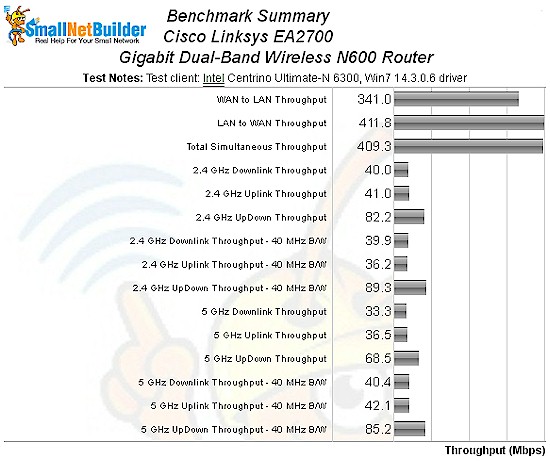
EA2700 benchmark summary
Wireless Performance – 2.4 GHz
A look at the 2.4 GHz downlink chart, filtered for dual-band routers shows the EA2700 only toward the top of the lower half of the chart with a 40 Mbps overall average for this mode in all four test locations. The EA2700 did much better for uplink, though. Its 41 Mbps overall average earned it the #3 spot in the chart!
To get a more detailed look, I ran a Performance Table adding the E2500, E3200 and EA3500 for comparison. Only the EA3500 is directly comparable, because it was tested with the same Intel 6300 client. The other two routers were tested with the Intel 5300.
That said, the EA2700 seems to perform equally well running up and downlink. Its speeds in that mode are better than the E2500 and E3200, but that could be due to the different test client used. Comparing directly with the EA3500, however, shows the EA2700 with a speed disadvantage. The EA3500’s Marvell chipset appears to get more bandwidth from the Intel client (or maybe it’s the other way around).
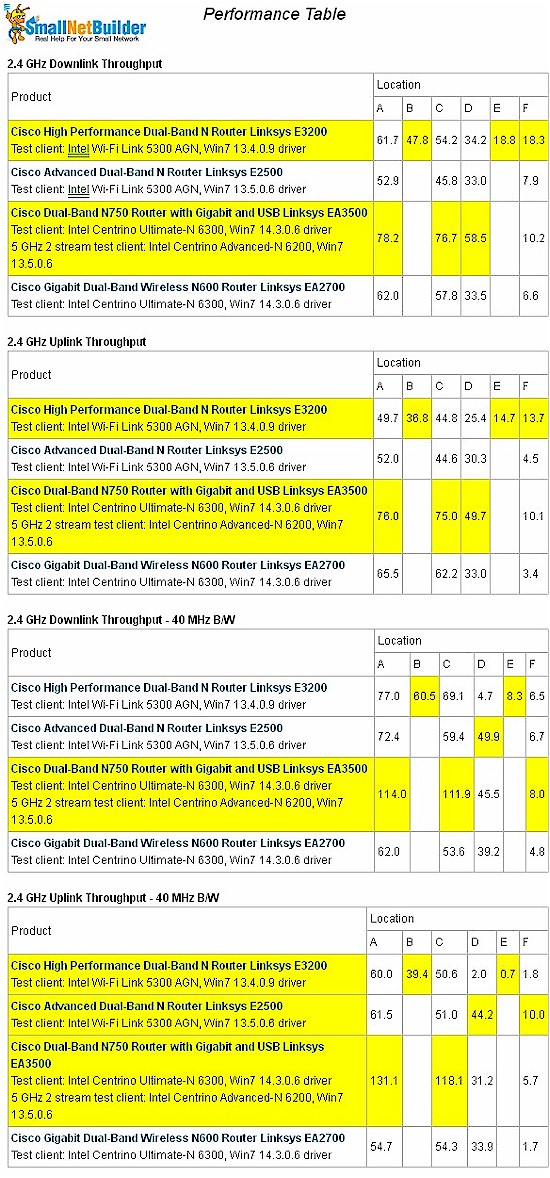
EA2700 Performance Table – 2.4 GHz
This advantage is also shown in the simultaneous up/downlink tests where the EA3500 and EA2700 came in at 94 and 82 Mbps total throughput, respectively.
Even though I could now get 40 MHz mode link rates, performance in that mode is virtually the same as in 20 MHz bandwidth mode. So it looks like you’re not really at a disadvantage if you can’t get the higher link rates.
The IxChariot plot summary below for 20 MHz mode downlink shows generally stable throughput, which is also seen in the other plots.
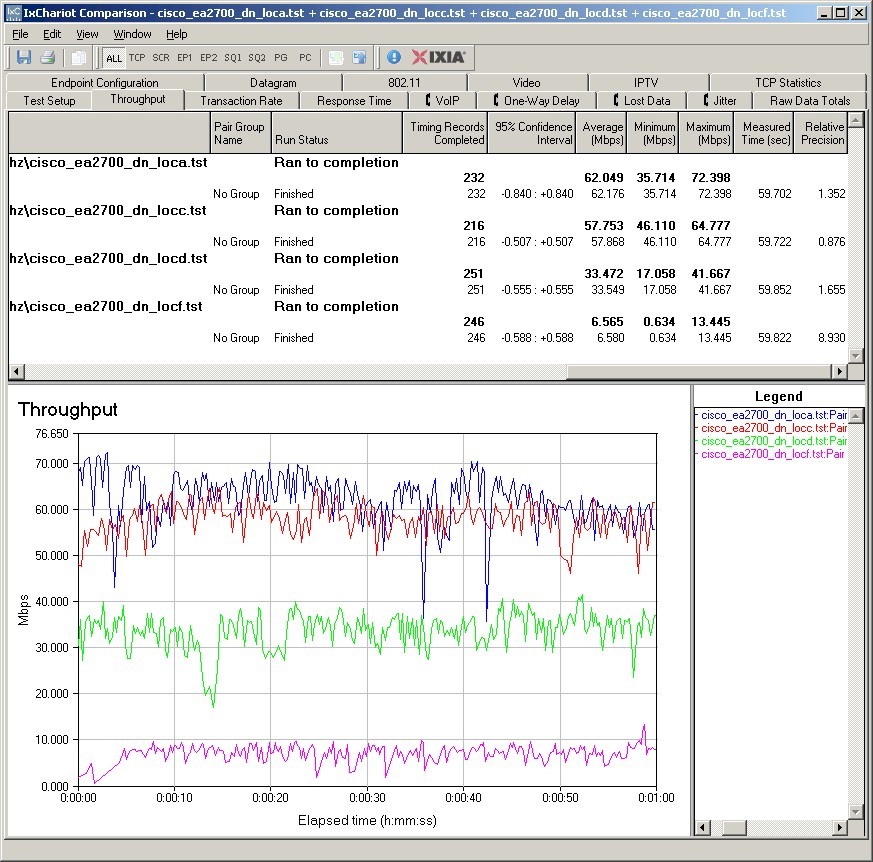
Cisco EA2700 IxChariot plot summary – 2.4 GHz, 20 MHz mode, downlink
Here are links to the other plots for your reference.
- 2.4 GHz / 20 MHz uplink
- 2.4 GHz / 20 MHz up and downlink
- 2.4 GHz / 40 MHz downlink
- 2.4 GHz / 40 MHz uplink
- 2.4 GHz / 40 MHz up and downlink
Wireless Performance – 5 GHz
Moving up to 5 GHz, we can again see higher throughput from the EA3500 vs. the EA2700 in the strongest signal test location A. This advantage fades as signal levels drop, however. Although the test client did show link rates above 130/144 Mbps during testing, there doesn’t seem to be much throughput gain from using 40 MHz bandwidth.
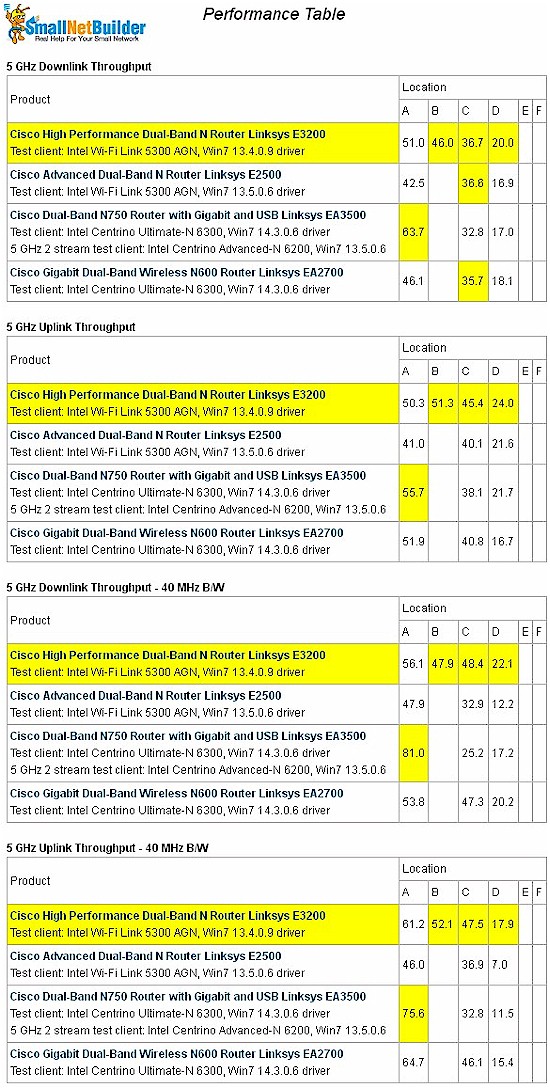
EA2700 Performance Table – 5 GHz
Simultaneous up/downlink tests also showed throughput gain in this band, yielding 69 Mbps in 20 MHz mode and 85 Mbps in 40 MHz mode.
The IxChariot plot summary for 5 GHz, 20 MHz mode downlink in two-stream mode is below and shows some rate shifting at the start of the Location D test run. I ran the test multiple times with similar results.
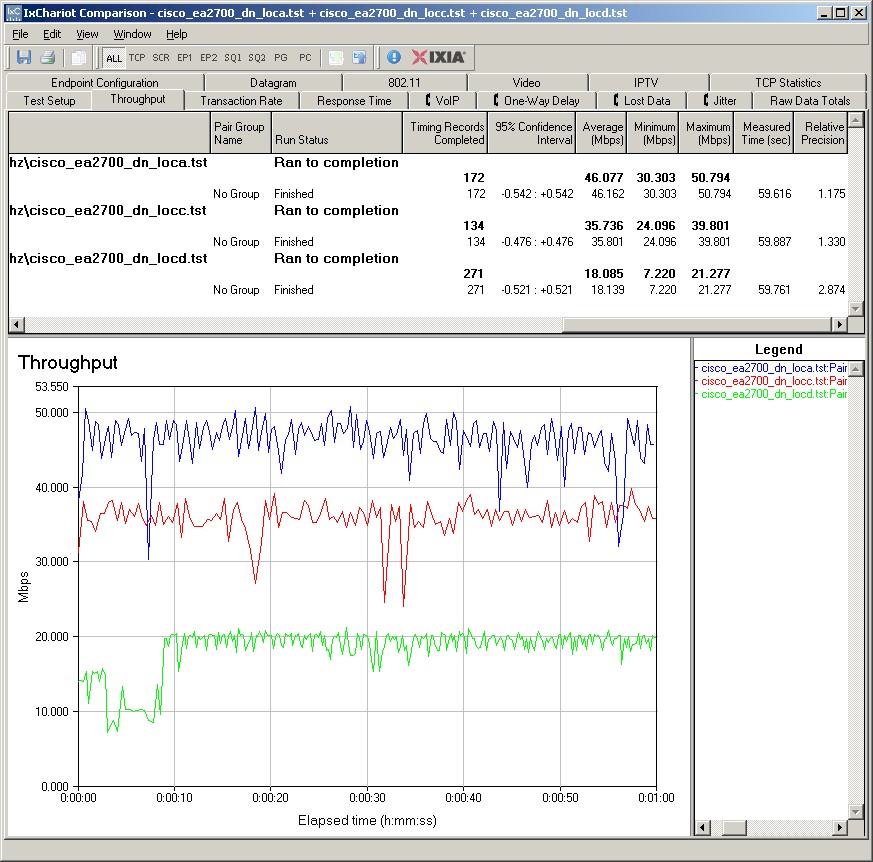
Cisco EA2700 IxChariot plot summary – 5 GHz, 20 MHz mode, downlink
Here are links to the other plots for your reference.
- 5 GHz / 20 MHz uplink
- 5 GHz / 20 MHz up and downlink
- 5 GHz / 40 MHz downlink
- 5 GHz / 40 MHz uplink
- 5 GHz / 40 MHz up and downlink
Closing Thoughts
Similar to the EA3500, the EA2700 doesn’t set any new wireless performance standards. In fact, its standout feature is that its throughput in 20 and 40 MHz bandwidth modes is suprisingly similar. And at least until (or if) Cisco fixes it, the EA2700 bears the distinction of being the only 802.11n router tested to date that won’t switch to 40 MHz bandwidth modes in 2.4 GHz if you manually set the channel.
If you’re on the fence between the EA2700 and EA3500, my advice is to spend the extra $30 and get the latter. Or if you don’t care about Cisco’s "app-enabled" future and don’t mind 10/100 ports vs. Gigabit, save $10 and get the E2500.
